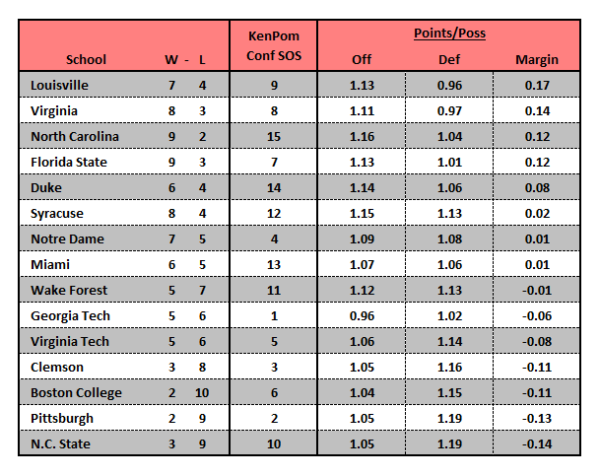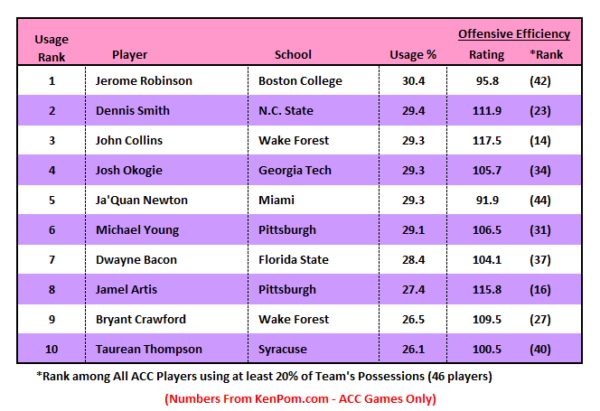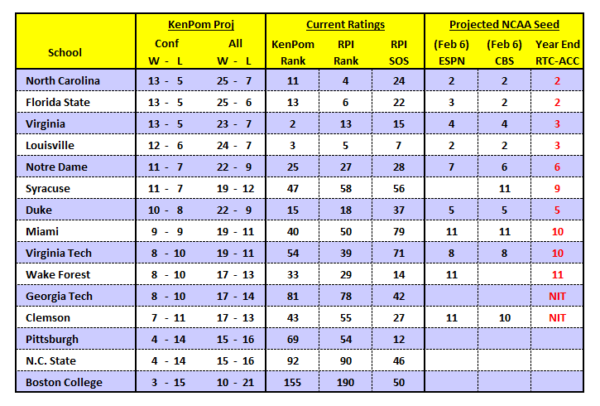Inside the ACC Numbers: Volume IV
Posted by Brad Jenkins (@bradjenk) on February 10th, 2017Here is the latest edition of our weekly review of the current ACC standings and team performances where we focus on which teams are playing better or worse than their records indicate. Each week we delve into advanced metrics to reveal a few interesting teams, player statistics and trends. This week we will compare some ACC player usage rates with offensive efficiency, seeing where some teams might benefit from a shift in possessions. Finally, we forecast how the final ACC standings may look given current efficiency margins, and what that means for teams’ postseason aspirations.
Note: All data is current for games played through Wednesday, February 8.
Current Standings

Syracuse‘s rise up the league standings is the story of the week. Jim Boeheim‘s club has now won five straight games by 10 points or fewer. The Orange’s close game effectiveness is why their record outshines a relatively low efficiency margin. For similar reasons, North Carolina continues to top the league standings despite trailing Louisville and Virginia in per possession performance. Florida State‘s efficiency margin now lines up nicely with its record after blasting its last three opponents by an average of 30 points per game.
Advanced Statistic of the Week: Player Usage vs. Efficiency

The table above shows the ACC’s top 10 players in usage during conference games. Player usage is defined as the percent of total team possessions that end with that player attempting a field goal, turning the ball over or making a trip to the foul line. The table shows that efficiency levels vary greatly. Kudos to Wake Forest big man John Collins and Jamel Artis from Pittsburgh — the only two players who also rank among the ACC’s top-20 in offensive efficiency. Usage and efficiency numbers are not produced in a vacuum. We often see players with decent offensive ratings who are simply not skilled enough to take on a higher usage rate – usually stand-still jump shooters and immobile big men whose shot attempts are almost always at the rim. And sometimes guards on less talented teams are forced into high-usage rates — certainly this is the case with Boston College’s Jerome Robinson — because their teammates are incapable of taking on more offensive responsibility. Now let’s look at how three ACC teams are dividing up possessions among their three highest usage players.

In each of these three cases, it appears as if there would be some benefit if player possessions were internally reallocated. This is especially true at Miami. We know that Ja’Quan Newton is not a natural point guard but it would probably help the Hurricanes’ offense if Jim Larranaga could convince Newton to transfer some of his possessions to Davon Reed and Bruce Brown. Duke may have already begun to shift its possessions more efficiently. In its last three contests — all wins for the Blue Devils — Jayson Tatum‘s usage rate has been reduced to about 22 percent. Tatum’s efficiency has as a result been much improved with an average offensive rating of 113.0 over that three-game span.
Future Forecast

The above table shows predicted order of finish with final regular season records based on KenPom’s current win probabilities for each team. Also included are a few comparative rankings that are mentioned frequently when evaluating NCAA Tournament potential, as well as projections from two bracketology experts–ESPN‘s Joe Lunardi and CBS Sports‘ Jerry Palm. Note that while they project the field as if it were named tomorrow, we make our projections based on the final KenPom projected records.
Each network bracketologist still has 10 ACC teams in the field but they differ on who the league’s final at-large school will be. Note that their brackets were completed before Syracuse’s win at Clemson on Tuesday night, so the Tigers are probably going to get bumped on the next update. On the other hand, the Orange now have to be considered well on their way to getting the necessary number of conference wins it will take to have their name called on Selection Sunday. If Virginia Tech and Wake Forest end up in an 8-10 tie in ACC play, it will be interesting to see if the Selection Committee likes both teams enough to include them in the field. The Hokies have a solid overall record to lean on while the Deacons have a top-15 strength of schedule rating in their favor.










































